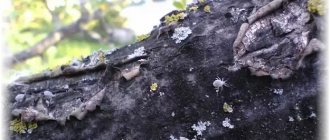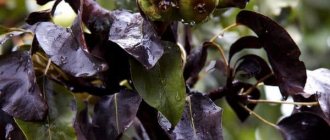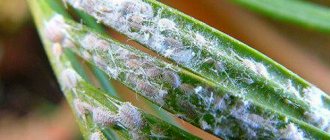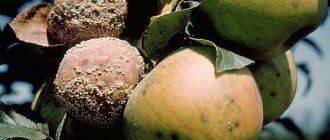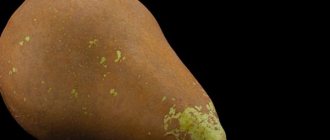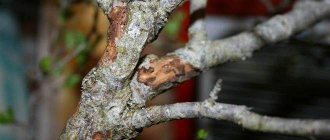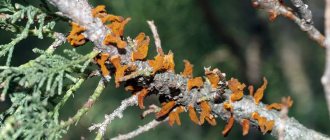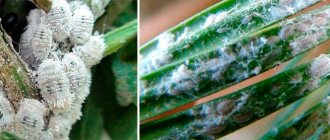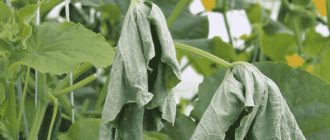Author: Natalya Category: Fruit and berry plants Published: July 07, 2015Republished: February 07, 2019Last edits: November 02, 2020
- Aphids on an apple tree
- When to spray
- What to feed
Apple tree (lat. Malus) is a genus of deciduous shrubs and trees of the Rosaceae family with sweet and sweet-sour spherical fruits. The apple tree supposedly originates from Central Asia and is found wild in almost all European countries. The genus includes 36 species, among which the most common are the domestic or cultivated apple tree (Malus domestica), the plum-leaved or Chinese apple tree (Malus prunifolia) and the low apple tree (Malus pumila). Cultivated varieties of apple trees, of which there are about seven and a half thousand, have been grown by humanity for a millennium, and almost all of them originated from the domestic apple tree.
Botanical description
The domestic apple tree is a small tree, reaching a height of no more than eight meters, it has a spreading crown consisting of generative and vegetative shoots. Leaves on short petioles are arranged alternately on the branches. White flowers with a pink tint form a corymbose inflorescence; they are most often pollinated by bees (apple trees are honey plants). The fruits of different types and varieties of apple trees differ in color, size and shape, taste, and smell. Inside each fruit there are about ten seeds, covered with a dense brown shell. An apple tree can grow in almost any soil; in forests and on roadsides there are luxurious trees that no one cares for, nevertheless, they bear fruit year after year, but still it is the correct planting and care of the apple tree that is the key to its health, high productivity and longevity.
Signs
The peak development of the sore occurs in the last month of spring or the first month of summer, when leaves rapidly bloom and develop on the trees.
First, small yellow-green spots appear on the surface of the leaf plate, then they cover the entire leaf and darken, acquiring a rich red color.
The fungus sucks out all the juices from the aboveground part of the plant, affecting not only the leaves, but also shoots, flower buds, and ovaries. At an advanced stage, the infection spreads to the trunk bark.
If the necessary treatment measures are not taken, the tree stops growing, bearing fruit and dies after a while.
Apple tree diseases and their treatment
Signs of illness
Unfortunately, there are many diseases that affect apple trees and destroy their fruits, and sometimes the tree itself, and it is very important to quickly detect the disease and immediately begin its treatment, so as not to regret later that the apple tree has died. In order to be able to correctly determine the nature of the disease, you need to have knowledge about the diseases and their symptoms. Each disease manifests itself in its own way, and if you notice unexpected changes on the leaves, bark, roots or fruits of an apple tree, check the information about disease symptoms and pest damage on our website.
We carefully systematize all information about plants, their diseases and pests, present them in detail and in an accessible way; the experts on our website are always ready to give readers recommendations and useful tips on how to treat an apple tree or any other plant, how to maintain the health of your garden.
- Strawberries: planting and care, growing from seeds
The apple tree is turning yellow
When autumn arrives, the leaves of all deciduous trees change color and then fall off. But how can we find an explanation for the fact that the leaves of the apple tree turn yellow in June? When the root system of an apple tree suffers from waterlogging, it will definitely let you know by changing the color of the leaves from green to yellow. And it will also react in the same way to improper soil moisture: if on a hot sunny day you sprayed the leaves of an apple tree while watering, burns may form in place of the drops - yellow spots.
Apple trees in the garden also turn yellow from a lack of iron in the soil, when the tree is damaged by pests, if the roots of the apple tree are undermined by a mole or its bark is damaged by rodents, and also if the apple tree is affected by scab or brown spot. This is why the leaves on an apple tree turn yellow, and we will tell you how to get rid of these problems in the relevant sections of the article.
Spots on leaves
Gray spots with a light green coating on the upper side of the leaf are an early sign of scab disease. Yellow spots are a sign of brown spot or a later symptom of scab. Red spots, or rather, swellings on the leaves of red or red-yellow color, are a sign of the presence of red gall aphids on the leaves of the apple tree, and small reddish spots indicate the fungal disease black cancer. Rusty-colored spots on an apple tree are a manifestation of another fungal disease - rust.
Apple tree leaves curl
Most often, this is evidence of the presence of aphids on the apple tree, which suck the juice from the plant, as a result of which the leaves of the apple tree curl and fall, exposing the tree. how to treat an apple tree against aphids in the section dedicated to this pest. Leaves from the apple tree also curl and fall off in case of powdery mildew.
The apple tree turns black
If the branches of an apple tree turn black, then this is most likely black cancer - one of the most dangerous diseases, from which parts of the plants located above the wound die. The lesions can be stopped. The best remedy in the fight against black cancer is copper sulfate. More on this in the next section. If the trunk and branches of the apple tree look as usual, but black leaves appear on the apple tree, then this may mean that you missed the onset of the tree scab and are now observing the development of the disease.
The apple tree is drying
Do not think for a long time about the question of why the apple tree is drying out, but take immediate action, since such symptoms most often indicate that the cause of the disease is black apple tree cancer, or Antonov fire, or fireworm. This fungal disease affects not only the apple tree, but also the pear. First, dirty purple stains and depressed spots appear on the bark of the branches and trunk, growing in concentric circles, then the bark cracks, turns black, as if charred, covered with “goosebumps” - fungal spores. On apples affected by the fungus, depressed brown spots appear, which alternate with light circles. Over time, such a fruit wrinkles, turns black and dries out, becoming covered with fungal spores. Trees that are more than twenty years old usually suffer from black cancer, but you need to take care of the health of the apple tree from a young age.
Similar symptoms occur in a common fungal disease that affects apple and pear trees – cytospora blight. Like fireweed, cytosporosis affects weakened trees with damaged bark, which is why it is so important to monitor the condition of the bark of fruit trees. Areas of the apple tree affected by cytosporosis acquire a reddish-brown tint, become covered with tubercles with fungal spores, and as a result, the apple tree partially dries out, and in advanced cases, the entire tree may die.
To cure an apple tree from black cancer and cytosporosis, you need to:
- trim diseased branches;
- clean the wounds on the trunk and branches with a sharp sterile instrument, capturing 1-2 cm of healthy tissue;
- treat all sections with three percent copper sulfate and cover with garden pitch;
- fill up hollows;
- collect and burn affected fruits.
You need to check the condition of the cuttings and inspect the trees for relapse every two to three weeks, and do not forget to treat the trunk with lime in spring and autumn.
Premature drying of leaves on an apple tree is most easily explained by drought in the summer and insufficient watering. If the branches and bark are in order, watering is carried out according to the laws of agricultural technology, but nevertheless the leaves on the apple tree dry out, then this may be the result of the disruptive work of moles or a consequence of a natural disturbance in the water exchange of trees, when an early warm spring comes after a very frosty winter. There is hardly anything that can be done here. However, do not rush to clear the area of such trees: they may move away next year. And carefully monitor the condition of the bark on garden trees: its integrity is the key to their health.
Apple tree cancer
In addition to black canker, the apple tree is susceptible to common canker and root canker. Common cancer affects the skeletal branches of the apple tree, second-order branches and tree bark. When an apple tree gets frostbite in winter, damage appears on it, and if fungal spores get into such a wound, the wounds will no longer heal. The bark in the affected area dies, dries out, and eventually falls off completely. This is common cancer. In winter, cancer development stops.
Apple tree root canker disease begins with the penetration of rod-shaped bacteria living in the soil into the cracks of the root system of trees, causing rotting nodules and growths to form on the roots, in which a huge number of harmful bacteria breed. The worst thing is if the cancer affects the root collar - in this case the tree will almost certainly die.
In case of severe infection, trees and skeletal branches, which are no longer useful to treat, must be cut down and burned. Lubricate cuts and cracks in the bark with a one percent solution of copper sulfate and apply garden varnish to the cuts. However, the fight against apple tree diseases always begins with a high level of agricultural technology and careful care, because weakened and unkempt trees are the first to get sick.
- Apricot: growing in the garden, types and varieties
Scab on an apple tree
Scab is one of the most common fungal diseases of apple and pear trees, affecting leaves, flowers, fruits and shoots. Favorable conditions for the activation of the fungus are watering apple trees with sprinkling, frequent rains, fogs and heavy dew. The fungus spends the winter on fallen leaves. The first sign of scab is the appearance of light green oily spots on the upper side of the leaves, which over time become covered with a brownish-olive velvety coating. Then the fruits of the apple tree become stained, crack and become deformed.
How to deal with scab? The best results are obtained by treating apple trees and the soil under them at the moment the buds begin to open with Bordeaux mixture (400 g per 10 liters of water), but if you did not have time to spray within this time frame, then treat the apple trees during the budding period, but not four-, but one percent solution of the drug. The next (second) spraying of apple trees with a one percent solution of Bordeaux mixture (or another fungicide) must be carried out immediately after flowering, and two to three weeks after the second treatment, a third one is carried out.
If the disease is advanced, it is permissible to spray apple trees with fungicides up to six times, but be careful when choosing a product so as not to burn the leaves of the trees - select several control branches and carry out a test spraying on them.
Good results in the treatment of garden trees from scab and other fungal diseases were given by such drugs as Vectra, Skor and Zircon. Don’t forget to remove fallen leaves from under the apple trees in the fall and dig up the soil around the tree trunk. By the way, there are varieties of apple trees that are resistant to scab: Antonovka, Pepin saffron, Pepin London, Jonathan and others.
Brown spots on an apple tree
Brown-brown spots with an olive tint on the leaves of an apple tree are a sign of scab disease, which we have already told you about. Sometimes brown spots on apple tree leaves can occur due to brown spot, a fungal disease that appears in early summer and develops at an incredible rate. These spots resemble burns from excessive or careless use of pesticides. You can fight brown spot using the same methods - spraying with fungicides (captan, zineb, one percent solution of Bordeaux mixture).
Rusty leaves on an apple tree
This is a sign of a fungal disease - rust, which appears in mid-summer: first, rusty spots appear on the apple tree on the upper side of the leaf plate, they gradually blur, and then star-shaped growths form on the underside of the leaves. As a result, the leaves fall untimely, and this reduces the winter hardiness of apple trees and undermines their immunity. Most often, apple tree rust occurs if juniper grows nearby, and as a preventative measure, it is necessary to cut off fungus-affected juniper branches in early spring to prevent the disease from spreading to your garden.
Rust on an apple tree is not a death sentence, but a signal to action: fungal diseases are treated with fungicides - Bordeaux mixture, sulfur preparations. Do not delay in solving the problem, eliminate the cause, carry out intensive treatment of the apple trees, and most importantly, draw conclusions for yourself and do not repeat mistakes in the future.
The apple tree does not bloom
The reason for this may be damage to the apple tree by severe winter frosts, causing its trunk and branches to become fragile, and a sooty coating to appear on the bark. Flower buds are severely damaged by frost and do not bloom in the spring, and, therefore, the apple tree does not bear fruit. We are not able to change the laws of nature or the climatic conditions in the region, humanity has not yet learned to control the weather, but even a novice gardener can increase the cold resistance and immunity of garden trees to diseases and pests by maintaining a high level of agricultural technology - correct and timely application of fertilizers, care crown, balanced watering, hilling the apple trees with snow, protecting the most vulnerable areas on the trees to frost.
In addition, the apple tree may not bloom if, when planting, you buried the root collar into the ground, if the branches of the apple tree are located almost vertically (the apple tree bears fruit only on horizontally located branches) and if the tree is deficient in iron.
The apple tree is withering
The reason for this may be moles that undermine the roots of the apple tree. It’s difficult to get rid of them, but quite possible: put a hose on the exhaust pipe of a car or motorcycle, and lower its other end into the detected mole hole, let the engine run for 30-40 minutes, while you watch the surface of the area, and if you see a trickle smoke escaping from the ground, immediately fill up the discovered passage with earth. The more passages you find and close, the more confident you can be that moles will not appear in your garden for at least three to four years.
But it happens that the apple tree simply does not have the strength to grow, so give it a rest this year, performing all the necessary agrotechnical procedures, and it is quite possible that next spring it will bloom and produce a harvest.
The apple tree is crumbling
If you overdo it with nitrogen fertilizers (urea, humus or liquid manure) in the spring, the apple tree will produce abundant foliage, but the fruit pulp will be loose and many of them will most likely fall off. To prevent this from happening, water the tree with a superphosphate solution (25-30 g per ten liters of water) at the rate of one bucket per m² of tree trunk circle. Another reason for the massive falling of fruits from an apple tree may be a lack of potassium: feed the tree with potassium fertilizer, and the problem will be resolved. The third reason may be an imbalance in the water balance - either too much or insufficient watering of the soil around the tree trunk.
The reason that the fruits fall off the apple tree may be fruit rot due to damage to the apples by the codling moth. Read about how to deal with this pest in the corresponding section of the article, and fruit rot is destroyed by two sessions of spraying the apple tree with a solution of the fungicide Hom at the rate of 40 g of the drug per bucket of water: the first - during the blossoming of the leaves, the second - after the apple trees bloom. Consumption: 5-6 liters of solution for each tree.
Why does it fall
Apple tree loss of leaves in the fall is a natural phenomenon for deciduous trees, but if the leaves fall prematurely, it may be due to a lack of potassium. If the leaves turn yellow before they fall, you will find the answer to the question of what causes this in the section “The apple tree turns yellow.” Actually, apple trees respond to almost all stress, such as disease, pest or rodent invasion, drought, frost, and so on, by losing foliage.
- Cucumbers: why they dry in the greenhouse and in the garden
Powdery mildew
Powdery mildew is a long-known enemy of gardens and flower beds. It affects shoots, bark, leaves and buds, forming a dirty white loose coating on the apple tree, which gradually becomes brown with dark inclusions. The leaves turn yellow and dry, the shoots do not grow, the tree stops bearing fruit and fades away. The mycelium can overwinter and resume its destructive work with renewed vigor in the spring.
The fight against powdery mildew begins at the moment when young leaves bloom - the apple tree is sprayed with one percent Bordeaux mixture or a solution of Skor or Topaz at the rate of 2 ml of product per bucket of water. After flowering, treat the trees with copper oxychloride or Hom (40 g per bucket of water). The third treatment is carried out with one percent Bordeaux mixture or a solution of 50 g of copper sulfate and 20 g of liquid soap in a bucket of water.
milky shine
Milky sheen is a little-studied disease, and methods of combating it are little known to scientists and breeders. There is a version that the shine appears due to freezing of the tree trunk or acute starvation of the plant (water or mineral).
Apple tree affected by milky shine
It is believed that infection occurs through a poisonous fungus, the spores of which penetrate into the tree through cracks or other damage in the bark. The shine itself is a gray metallic color, but this is only on the upper side of the sheet. On the bottom, the color changes from purple to brown during the period of illness.
Fungal spores infect wood mainly in damp, wet weather. At such times, it is better to refrain from pruning, so as not to replenish the mechanical wounds of the apple tree trunk. The disease spreads from one branch to entire hollow parts of the tree over several years.
Signs of milky shine
At the same time, science does not know exactly what kind of fungus infects trees and what control methods to use against it. It is known that the virus penetrates wood, destroying it. Outwardly, the disease is invisible until the leaves are covered with a metal curtain. As a result of this disease, the fruits become tasteless and unsuitable for storage and consumption.
READ ALSO: Rash after fever and nothing else - this is infantile roseola - Diagnostician
How to fight?
You should grow zoned trees, purchase disease-resistant species, and monitor the winter hardiness of the individual, that is:
- do not grow trees in wet, swampy areas;
- do not deprive the apple tree of a range of fertilizers to increase immunity;
- water trees abundantly only in the first half of the growing season;
- in autumn and spring, the trunks should be coated with lime milk (2 kg of lime per 10 liters of water) with the addition of copper sulfate;
- trim and burn severely affected parts of the tree;
- clean the bark from mechanical damage and cracks, disinfect them with a solution of copper sulfate (10-20 g per 1 liter of water).
If all efforts to combat the disease are in vain, then it is advisable to destroy the infected trees.
Apple tree pests and their control
Aphids on an apple tree
Green apple aphids are the most common insect pest in orchards. It forms entire colonies on shoots and leaves, eats and spoils greenery, and covers habitats with honeydew, a product of its vital activity.
How to fight aphids? The natural enemy of aphids is the ladybug, but if you rely on the fact that these red and black-speckled bugs will appear in the garden in the required quantity and destroy the aphids, you can ruin the apple tree. Therefore, in the spring, it is best to treat the tree with a three percent solution of karbofos on dormant buds in the fight against aphids. If the buds have already begun to bloom, then the concentration of the solution should be weaker - 2%, and if you have to spray on green growing shoots, then make a one percent solution.
Instead of karbofos, you can use such agents as phosphamide, Zolon, Aktara, Fitoverm in the concentration recommended by the manufacturer.
Caterpillars
If you are a novice gardener, then you have no idea how many types of caterpillars can harm your apple tree. Insects such as apple and pear sawflies, apple glass moths, apple and oriental codling moths, apple moths, rowan moths, fruit and hawthorn circle moths, apple leaf roller moths, fruit striped moths, blue-headed cutworms, currant leaf rollers, striped moths, subbark and fruit leaf rollers , gypsy, oakleaf and ringed silkworms, leafminer moths, hawthorn... The caterpillars of these insects parasitize on different parts of the apple tree, feeding on them and undermining the health of the tree.
They all do not look the same: silkworms, for example, have shaggy, dark brown or brown, almost black caterpillars, 6-7 cm long; leaf rollers have green ones and are no longer than two and a half centimeters, but both of them harm the plant and pose a threat to him. How to deal with caterpillars? If you find spider web nests in the spring, they must be cut off and destroyed by fire, preventing the caterpillars from spreading. During bud break, treat the trees with a seven percent solution of karbofos or three percent solutions of chlorophos or nitrafen.
Spider web on an apple tree
A pest such as the apple moth lays eggs on young branches (at the base of the buds, on the branches), and the caterpillars that appear in the spring eat up the buds, and then attack the young leaves, feed on them, then make a dome out of cobwebs and live under it in a colony of 50- 70 pieces. Caterpillars on an apple tree in a web create a new voracious generation, which with an appetite destroys the leaves of the apple tree. The leaf roller behaves in approximately the same way, appearing in the form of a caterpillar and damaging the buds and buds of the apple tree, dragging the leaves with a web.
How to deal with cobwebs on an apple tree and moth caterpillars that have formed cobweb nests? In this case, treating the tree with a three percent solution of nitrafen in early spring and spraying it with a seven percent solution of chlorophos or a two percent solution of Zolon after bud break will help you.
Ants on an apple tree
Ants are a real disaster for any garden. If there is an anthill on your property, then there will be aphids, and no matter how much you fight the aphids, they will appear again and again, as if ants alone are not enough. Ants that appear in the spring gnaw away the buds of the apple tree, and if they come to the tree during the fruiting period, they can thoroughly ruin your harvest, since they themselves feed on the juice of the fruit, and even place their livestock - aphids - for grazing in your garden.
It is necessary to fight ants radically, because they will not go away on their own, and it is best in this fight to combine means that destroy both ants and aphids. In addition to karbofos, actara, actellik and other insecticides are used against aphids. It’s a little more complicated with ants: using ant-killing chemical aerosols like Raptor or Combat in the open air will not give the desired effect, and gel preparations with the same names can kill not only ants, but also bees, and this is an environmental crime. Therefore, it is best to use special traps with poison inside, which are a washer with small slots into which an insect larger than an ant will not pass. Having fallen into a trap and being poisoned by a slow-acting poison, the ant returns to its anthill and infects its fellows there.
If you are opposed to such measures, we offer you another way out: a smooth metal ring, very tightly placed on the barrel. Due to the smoothness of the metal, ants will not crawl through the ring and, therefore, will not be able to harm your apple tree.
leaf roller
The leaf roller appears in the spring from cocoons in the bark of a tree. Green caterpillars with brown specks eat apple tree buds and buds, producing cobwebs. By mid-summer they pupate in the leaves they fold. The difficulty is that these caterpillars are very difficult to see, so it is better not to wait for them to start eating your future harvest, but at the very beginning of spring, treat the apple tree with a solution of nitrafen (3%), and then use a seven percent solution of chlorophos for spraying.
Mite on an apple tree
Not only apple trees can suffer from red mites, but also pears, cherries, sweet cherries, plums and even rowan trees. During the flowering of the apple tree, mite larvae, which have overwintered in cracks in the bark at the base of annual shoots, approach the young opening leaves and cover them with their bodies, like a red coating. After three weeks, the larvae become adult insects and lay eggs on the leaves. During the season, the spider mite reproduces 5-6 generations, parasitizing the ends of the stems and leaves of the apple tree. Thin cobwebs appear on areas of the apple tree damaged by mites.
In case of severe damage, the apple tree is treated with nitrafen or oleocuprite before the buds open; if you find an uninvited guest during the formation of buds, it is better to use karbofos, metaphos, phosphamide or colloidal sulfur for spraying. If you are not sure that all mites have been destroyed, treat the apple tree a third time with one of the listed preparations after flowering, but do not use the same product twice so that the mites cannot develop immunity to it.
Be careful when using sulfur-containing preparations; do not spray the apple tree on a windy day, so as not to burn the leaves of the apple tree and other plants. The last treatment against mites is carried out no later than a month before harvest.
Codling moth on an apple tree
The codling moth is a very common and dangerous pest. It affects not only apple and pear trees, but also stone fruit trees - peach, nectarine, plum and quince. The codling moth overwinters in the soil or in the bark of a tree, wrapped in a dense cocoon, and at the end of flowering, codling moth butterflies appear, laying eggs on the set fruits and the upper part of the leaves. After two to three weeks, the caterpillars begin to spoil the apples, eating away at the middle and making their way to the seeds. Caterpillars destroy young shoots by gnawing tunnels in them, causing the branches to dry out and break.
To combat the codling moth, trees are treated with chlorophos or metaphos immediately after flowering, and the treatment is repeated two weeks later. Late varieties of apple trees are sprayed up to seven times per season.
Silkworm on an apple tree
If the caterpillars of the oakleaf and ringed silkworms damage mainly the leaves of the apple tree, then the gypsy moth, in addition to the leaves, devours the buds and ovaries of the fruit. Each silkworm caterpillar can destroy up to 35 leaves. By June, the caterpillars form cocoons in the tree crown, and butterflies emerge from them at the end of July. One butterfly lays up to 1200 eggs. If there is a massive invasion of silkworms, trees may be left without leaves altogether.
Inspect trees regularly and if oviposition is detected, treat it with the viral drug Virin-ENZh. Before the buds open, spray the apple tree with nitrafen, and before flowering - with karbofos, metafos, Zolon, chlorophos or another similar preparation.
How to treat an apple tree - prevention
When to spray
Preventive treatment of apple trees is carried out in early spring, before buds open, and in the fall, after harvest. Spring treatment is carried out in order to destroy insects that have overwintered in the garden and protect the trees from fungal diseases. The treatment is carried out in three stages: before the buds open, during the opening of the leaves and after it. Autumn preventative treatment of apple trees is carried out to destroy insects hiding in the cracks of the bark for the winter, and in order to prevent diseases of the apple tree.
Treatment for diseases
In early spring, before the buds swell, choosing a warm, windless day with a temperature not lower than 5 ºC, carry out preventive spraying of the apple tree and the soil under its crown against fungal diseases with copper sulfate or nitrafen solution. At the very beginning of the bud breaking process, in order to prevent scab disease, it is necessary to spray the trees with one of the following preparations:
- Bordeaux mixture;
- copper sulfate;
- inkstone.
If for some reason you did not treat the apple trees for scab before bud break, treat them with Bordeaux mixture, karbofos (urea), copper or iron sulfate during flowering. This will allow you not only to protect apple trees from scab, but also to destroy harmful larvae and eggs of caterpillars of moths, butterflies, ticks and sawflies, and if you give preference to iron sulfate or karbofos, your trees will receive additional nutrition in addition to protection. But this is only in case of emergency: it is better not to treat apple trees with chemicals during flowering.
In the summer, if necessary, treat the apple tree against fungal diseases with copper-containing preparations added to the solution of liquid soap.
In the autumn, after harvesting, but before the leaves fall, the garden is sprayed with urea for the last time as a preventive measure against diseases. This measure will also save you from harmful insects preparing for winter.
Pest treatment
At the very beginning of spring, before the buds swell, on a windless day at an air temperature of at least 5 ºC, trees and trunk circles under them are treated with a solution of nitrafen or copper sulfate in order to exterminate insects that have overwintered in the garden. As soon as the buds begin to bloom, choose one of the preparations suggested below and treat the apple trees with it against scab and insect pests of the buds:
- copper sulfate;
- inkstone;
- chlorophos solution (from caterpillars and weevils);
- suspension of colloidal sulfur (from mites).
Those who were unable or did not have time to carry out treatment before the onset of flowering of apple trees can, in case of emergency, treat the trees comprehensively against pests and diseases during flowering with the following preparations:
- Bordeaux mixture;
- copper sulfate;
- inkstone;
- suspension of colloidal sulfur, phthalan, captan or zineb.
At the same time, caterpillars, moths, honey moths, mites and aphids are exterminated with karbofos. To kill mites, it is best to use a keltan emulsion, and against caterpillars that damage leaves, treating the apple tree with an entobacterin suspension gives good results. However, spraying plants during flowering can harm pollinating insects, so try to avoid treating apple trees with chemicals during this period.
Immediately after flowering, using Bordeaux mixture, karbofos, copper or iron sulfate, scab is combated, as well as mites, sawflies, larvae and caterpillars of butterflies and moths. And after two to three weeks, a combined treatment of apple trees against scab, codling moth and other pests is carried out with a solution of chlorophos with the addition of urea. At this time, it is undesirable to use Bordeaux mixture, copper sulfate or copper oxychloride, as they can leave burns on the leaves and netting on the fruits of the apple tree.
In the summer, if necessary, apple trees are treated against pests with karbofos, actellik, inta-vir or other insecticides. It is advisable to do this no later than a month before the fruit ripens.
After harvesting, but before the leaves fall, carry out preventive treatment of apple trees and trunk circles with nitrafen or karbofos against harmful insects that have settled over the winter in the soil under the apple trees or in their bark. Urea, in addition to protecting against pests, will provide additional nutrition to apple trees.
How to reduce fruit toxicity
Of course, it is difficult for gardeners who have looked after their harvests with such trepidation and care to pick out all the affected apples. In such situations, I would like to know if there are any ways to reduce the toxicity of the fruit if the scab infection is minor.
There is no comforting information here; the toxins that the fungus produces do not disintegrate during heat treatment. Therefore, canning, making jams or preserves will not make such fruits healthier. If the disease has spread greatly, you need to destroy the entire harvest of this year and try to cure the tree so that the fruits can be eaten next season.
Fertilizing apple trees
What to feed
Proper nutrition of apple trees is the key to their health, longevity and resistance to diseases and harmful insects, which is why fertilizing apple trees is one of the most important conditions for proper agricultural technology.
- In the first year of a seedling’s life, additional feeding is not needed; the fertilizers that you applied to the site in preparation for planting are sufficient.
- A two-year-old apple tree needs 10-15 kg of organic matter per year, 70 g of nitrogen fertilizers (ammonium nitrate), 200 g of simple superphosphate and 80 g of potassium sulfate. You need to fertilize a circle around the trunk with a diameter of 2 m.
- A tree of the third and fourth year has a trunk circle with a diameter of two and a half meters and consumes 15-20 kg of organic matter, 150 g of ammonium nitrate, 250 g of simple superphosphate and 140 g of potassium sulfate per year.
The trunk circle of an apple tree in the fifth or sixth year increases to three meters, and the need for microelements increases in this way: each tree will require 20-30 kg of organic matter per year, nitrogen fertilizers - 210 g, phosphates - 350 g, potassium fertilizers - 190 g. Diameter The trunk circle of a tree that is 7-8 years old reaches three and a half meters, and one such apple tree needs fertilizer per year in the following quantities: from 30 to 40 kg of manure, 280 g of nitrogen, 420 g of phosphorus and 250 g of potassium.
An apple tree nine years old and older has a trunk circle of four and a half meters in diameter, and the need for microelements of one apple tree is as follows: organic fertilizers require 50-60 kg per year, nitrogen fertilizers - 280 g, phosphates - half a kilogram, potassium fertilizers - 340 g.
Phosphates, potassium fertilizers and the entire norm of organic matter are applied in the fall when digging the trunk circle in the first three years to a depth of 12-15 cm. After the third year of the apple tree’s life, when its root system goes deep, fertilizers are applied into specially made 3-4 wells up to half a meter deep , located at a distance of a meter and a half from the tree trunk.
Two-thirds of nitrogen fertilizers are applied during bud break, and the remaining third after the apple tree blooms. Ammonium nitrate, humus or urea can be used as such fertilizers. It is better to apply them to the tree trunk in fractions and in liquid form - as a solution of low concentration fertilizer in clean water. A nitrogen fertilizing scheme might look something like this:
- first feeding - from the beginning of bud break to the beginning of flowering;
- the second feeding - when the ovary becomes the size of a walnut;
- the third feeding - a month after flowering, when the shoots are actively growing;
- The fourth feeding is during leaf fall.
Root cancer
Root cancer is a bacterial disease. Swells and growths of different sizes form on the roots of the tree, which begin to rot. The bacterium penetrates through soil pests.
Appearance of root cancer
Root cancer on an apple tree seedling
They look like whitish tumors, soft in structure. The growths can reach 12 cm in diameter, compacting to a hard wooden state.
It is noted that the diseased tree sharply increases in growth, after which it begins to sag.
Root growths create a nutritional deficiency for the tree, reduce its resistance to the environment and durability, and also delay sap flow, reducing productivity.
READ ALSO: Wen on the labia and clitoris: how to get rid
Measures to combat root cancer
- Before planting seedlings, they must be carefully examined for defects or external signs of disease.
If growths are found, they should be removed and the root area disinfected.
It is better to plant seedlings of new trees in place of grain or legumes. It is this soil that will provide a good basis for growth. Also, planting mustard next to the apple orchard is a good prevention against root cancer.
